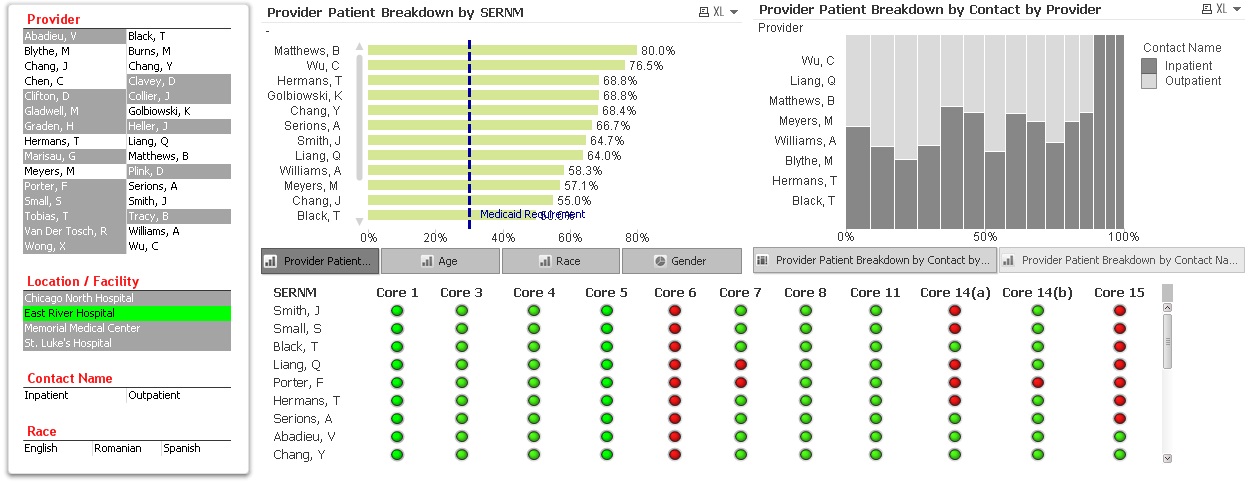Unlock a world of possibilities! Login now and discover the exclusive benefits awaiting you.
- Qlik Community
- :
- Forums
- :
- Groups
- :
- Industry and Topics
- :
- Healthcare
- :
- Wu's News - Meaningful Use
- Subscribe to RSS Feed
- Mark Topic as New
- Mark Topic as Read
- Float this Topic for Current User
- Bookmark
- Subscribe
- Mute
- Printer Friendly Page
- Feature this Topic
- Mark as New
- Bookmark
- Subscribe
- Mute
- Subscribe to RSS Feed
- Permalink
- Report Inappropriate Content
Wu's News - Meaningful Use
Meaningful Use is the hot topic in US Healthcare. President Obama's 2008 HITECH act incentivizes healthcare providers to adopt new technology in the hopes of modernizing an aging industry and decreasing the rapidly escalating costs of healthcare.
For the first years of Meaningful Use, healthcare providers are incentivized with a stimulus reimbursement for their investment in EHR technology. After, they are actually penalized for not doing so.

First the carrot, than the stick
The problems come in the implementation and the submission process for Meaningful Use. Meaningful Use will occur over several stages for healthcare providers in which they will need to demonstrate increasingly more robust use of EHR technology through an attestation process. Stage I and stage II metrics for Meaningful Use have been published by the Office of the National Coordinator (ONC) but have already undergone significant changes as measures are more accurately defined and more organizations complete their submission process and find exceptions.
For EHRs that are fully certified (as opposed to modularly certified) for Meaningful Use, customers have had significant issues with the standard MU reports coming from their EHR. Take for example one customer that realized that they were failing the Core Measure of Medication reconciliation for all patients upon admission to the hospital. They ran the reports over and over, and realized that the number being returned from the report was well below the threshold and they could not figure out why. After some deeper analysis into their EHR reports, they realized that the reports, by default, took into account all patients admitted - including newborn babies. An exception to this calculation was that newborn babies most obviously don't have any medications to reconcile upon admission (in this case delivery of the baby). They manually updated the report and their numbers skyrocketed.
By extension, another customer scrambled to implement a high-powered fully certified EHR by the end of June 2012 to insure that they had 90 days of data in 2012 to report for the full Medicare reimbursement amount. Their hope was to start receiving stimulus money in December to help pay for the expensive implementation of the EHR. In October, they ran the EHR's default reports for the first time so that they could be eligible for the stimulus and were deficient for almost every measure. What they realized was that several of the exceptions (like the one mentioned above) were required to be manually updated in the reports in order to get correct numbers. The work was more significant than they anticipated and to date, they are still unable to submit their first round of providers. Additionally, if their numbers aren't sufficient in 2012, they'll also lose out on the maximum reimbursement.

I told you it wasn't Alopecia!
The large problems with most EHRs is that they are not built for flexible reporting. They are built as a documentation system with analytics as an afterthought. While most of the major vendors are in the process of making this a more significant component of their long term strategy, the simple matter is the needs and problems most organizations face now cannot be met with the standard tools provided. This will become even more apparent as we move into the second and third stages of MU.
That's where QlikView comes in. Our bread and butter is to make large and complex sets of data digestible and flexible for consumption at every level. From the aggregate down to the transactional, we allow direct and valuable insight into data. Nowhere has this been more apparent to me than in healthcare. QlikView is especially valuable with regards to Meaningful Use, which requires very discrete calculations for metrics that fluctuate regularly. In fact, the Meaningful Use stage I requirements were just adjusted in a release from CMS three weeks ago. Where static reports from an EHR may get run weekly or even monthly, QlikView can run Meaningful Use reports daily or faster, giving direct care providers the ability to complete care or documentation for metrics they otherwise would be deficient in later. Many QlikView customers are doing just this.

Another big benefit is that there is no wait for an organization to have their EHR release new reports for any newly released metrics. They can be done as soon as the metrics are released from CMS, allowing a jumpstart into the attestation process. For the changes to stage I released recently, most EHR vendors are likely not close to completion of updates to their MU reports, meaning their customers must wait until they're done to see if they are meeting the new metric requirements. For many of the Meaningful Use Stage II metrics, they are simply a higher threshold of stage I metrics. Before you are even ready for stage II you can see how you're doing.

On Thursday, February 21, Chris Elfner from Bellin Health and I will be presenting a webinar on QlikView and Meaningful Use. We'll discuss how QlikView can be used as a flexible tool for providers to make sure they hit their metrics prior to the end of a reporting period. Additionally, we'll discuss how QlikView has been used by many customers to simplify the otherwise tedious process of attestation.
If you haven't yet, you can sign up here.
Up Next: You decide! Vote for the next topic in the survey here.
.
- Tags:
- Group_Blogs